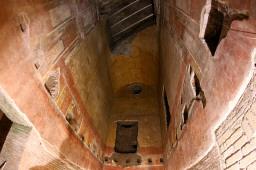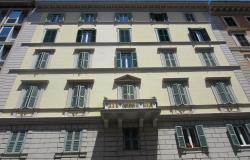One of Rome's prime tourist attractions, the ruins of Nero's Domus Aurea, will reopen again in two years' time after work to make it completely safe for the public, officials said Wednesday.
The fabled 'Golden House' has been closed since 2005 after masonry fell from flaking walls and a high level of dangerous seepage was detected.
The work will begin in a month's time, officials said.
This time, experts are determined to make the site secure so that access doesn't have to be cut off, said Culture Undersecretary Francesco Giro.
''Rome must be an open city, not off-limits,'' he said.
Officials said some 2,600 square metres of the site would be opened after the two-year scheme, leaving several areas still needing attention.
The top of the Domus on the Colle Oppio (Oppian Hill) is covered with parks, trees and roads whose weight and polluting effect are a constant threat.
Meanwhile, archaeological experts are still trying to unearth more of the massive baths that Emperor Trajan built over the Domus.
The golden palace of the ill-famed Emperor Nero (37-68 AD) first re-opened in June 1999 after 21 years in which it was Rome's best-kept secret - open only to art officials and special guests.
Some five billion lire (2.5 million euros) were spent in refurbishing the visitable rooms filled with surprisingly fresh and lively frescoes of weird animals like winged lions, griffins and tritons which led to the original coinage of the word 'grotesque', from the Italian word for cave (grotto).
After Nero's suicide in 68 AD the Flavian emperors who succeeded him proceeded to bury all trace of the man who already in life was a byword for dissolution, cruelty and excess.
The Flavian amphitheater, better known as the Colosseum, was built on the site of Nero's palace-side lake, while Trajan built his baths on top of the main part of the sprawling pleasure dome.
Ironically, the Colosseum is so-called because of the massive statue of Nero that his successors dragged beside their own monument - after changing the head, according to some ancient accounts.
Another irony is that, by burying the place, they actually preserved it so that the finest wall-paintings outside Pompeii, with almost equally vivid colours, can be admired today.
Other interesting touches are the chalk and tallow marks left by Renaissance masters like Raphael who were let down through a hole in the roof to admire its splendours.
At the time of its re-opening in 1999, officials said it would take another 50 billion lire to uncover all 150 rooms of the palace.
They said the Domus Aurea had the potential to become a site rivalling that of the Palatine with its palaces of the first Caesars.
Among the highlights of any visit will be the frescoes, of course, many of them illustrating the emperor's taste for the exotic in scenes from Homeric myth.
Architecturally, the piece de resistance is the eight-sided Sala Ottagonale where Nero is supposed to have entertained his guests with his singing and lyre-playing, all on a rotating floor.
At suitable moments in the fun, the sybaritic emperor is also reported - by Roman historian Suetonius - to have given the signal for marble panels to slide back, showering guests with petals and perfume.
When it was completed, a 50-hectare complex covering most of the Palatine, Celian and Oppian hills, Nero was reputed to have remarked that finally he was beginning to be housed like a human being.







